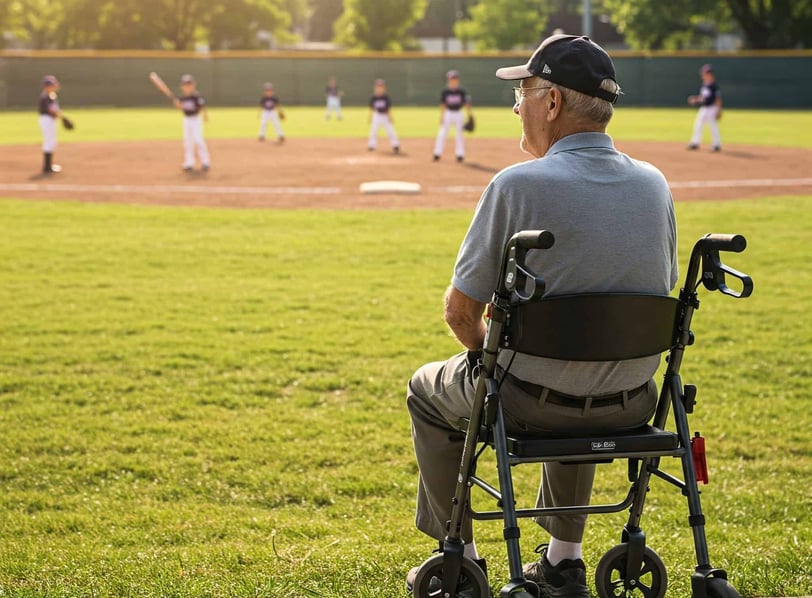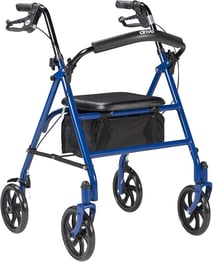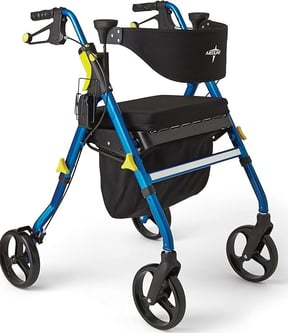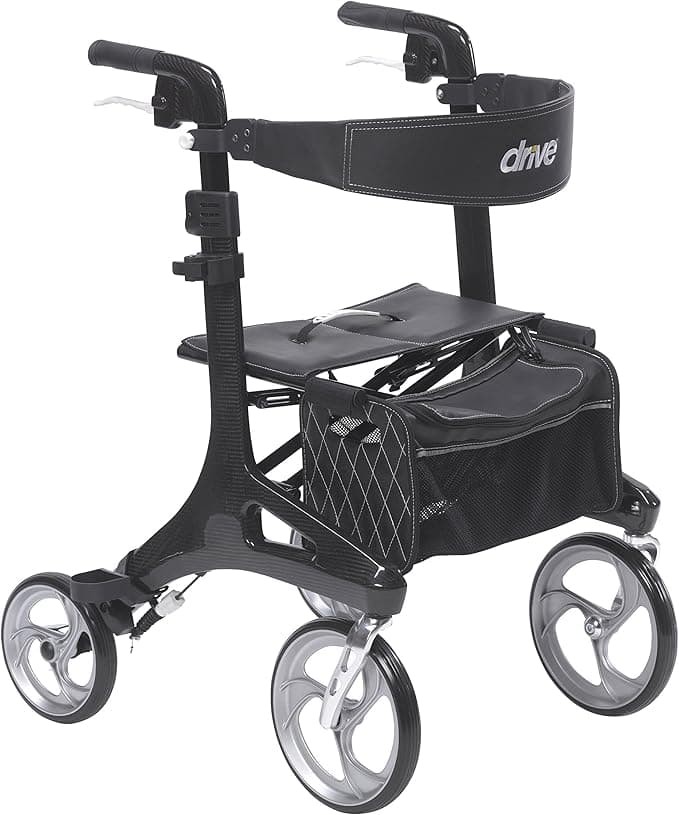When to Use A Rollator
Information on when to use a rollator and the different uses.
4/30/202512 min read
When to Use a Rollator: Essential Guidelines for Safe Mobility Support
Navigating daily life with mobility challenges can be difficult, but the right support tools make a big difference. A rollator is often the perfect solution when you need more stability than a cane provides but don't require a wheelchair. You should consider using a rollator when you experience balance issues, fatigue during walking, or need additional support while recovering from surgery or managing a chronic condition.
Rollators offer unique advantages with their four wheels, built-in seat, and storage basket. Many people find that a rollator helps them maintain independence and confidence when moving around. They're especially useful for longer outings where you might need to rest periodically.
Unlike standard walkers, rollators don't need to be lifted with each step, making them easier to use for people with limited upper body strength. They work well on various surfaces and can be folded for transport in most vehicles.
Key Takeaways
Rollators provide ideal support when you need more stability than a cane but don't require a wheelchair.
The built-in seat and storage features help maintain independence during longer outings.
Choose a rollator based on your specific mobility needs, body size, and the environments where you'll use it most.
What Is a Rollator and How Does It Compare to Other Walking Aids?
Walking aids come in various forms, each designed to support different mobility needs and physical abilities. Understanding these differences can help you choose the right device for your situation.
Definition and Features of a Rollator
A rollator is a walking aid with three or four wheels, handlebars for steering, and a built-in seat. Unlike standard walkers, rollators don't need to be lifted with each step, making them easier to use for people with limited strength.
Most rollators include these key features:
Wheels: Typically 6-8 inches in diameter for smooth movement
Hand brakes: For safety and control
Adjustable height: To match your body size
Seat: For resting when needed
Storage basket or pouch: For carrying personal items
Rollators offer greater mobility and independence for people with balance issues or those who tire easily. The seat provides a convenient resting option during longer outings, which other walking aids don't typically offer.
Differences Between Rollators, Walkers, Wheelchairs, and Canes
Rollators vs. Standard Walkers
Rollators have wheels; standard walkers must be lifted
Rollators move faster but require more coordination
Walkers provide more stability but limit speed
Rollators vs. Wheelchairs
Rollators require some walking ability; wheelchairs don't
Rollators promote physical activity; wheelchairs are passive
Wheelchairs provide complete support for those unable to stand
Rollators vs. Canes
Canes are for mild balance issues; rollators for more significant needs Click Pic for more info
Rollators provide more support and stability than canes
Canes are more portable and less conspicuous
Types of Walkers and Wheeled Walkers
Standard Walkers: Four-legged frames without wheels that provide maximum stability. You must lift these with each step, requiring more upper body strength.
Front-Wheeled Walkers: Two wheels in front, two legs in back. Easier to push than standard walkers while still offering good stability.
Three-Wheel Rollators: More maneuverable in tight spaces, lighter weight, but less stable than four-wheel models.
Four-Wheel Rollators: The most stable rollator design, ideal for outdoor use or uneven surfaces.
Knee Walkers: Specialized walkers for leg or foot injuries, allowing you to rest one knee while moving with the other foot.
Your mobility needs, strength, balance, and lifestyle should guide your choice between these different walking aids.
When to Use a Rollator: Key Indications and Considerations
Rollators provide essential support for those with mobility challenges. They offer stability and safety while encouraging continued movement and independence in daily activities.
Common Mobility Challenges Addressed by a Rollator
Balance issues are a primary reason to use a rollator. If you find yourself feeling unsteady when walking or have experienced falls, a rollator provides crucial stability.
Partial weight-bearing conditions, such as recovery from hip or knee surgery, may require temporary rollator use. This allows you to stay mobile while reducing pressure on healing joints.
Chronic conditions like arthritis, COPD, or heart disease that limit your endurance can be managed better with a rollator. The seat offers a place to rest when fatigue sets in during activities.
Pain when walking is another indication. The rollator redistributes your weight, reducing strain on painful joints or your back.
Common signs you might need a rollator:
Feeling unsteady when walking
History of falls or near-falls
Difficulty walking long distances
Needing frequent rest breaks
Ideal Candidates and Physical Requirements
You need adequate upper body strength to use a rollator safely. Your arms must support your weight when leaning on the handles and when sitting or standing.
Hand dexterity matters for operating brakes and adjusting the rollator. Most models require you to squeeze brake levers and lock them in place.
Physical requirements for safe rollator use:
Ability to stand fairly upright (not severely stooped)
Sufficient arm strength to support partial body weight
Good hand coordination for brake operation
Cognitive ability to navigate safely
Weight capacity varies by model. Standard rollators support 250-300 pounds, while bariatric versions can handle up to 500 pounds. Always check the specifications for your body weight.
Height considerations are important too. Your rollator should allow you to stand with arms bent at about 15-20 degrees at the elbow for proper posture.
Role of Physical Therapists in Rollator Selection
Physical therapists provide expert guidance in choosing the right mobility device. They assess your strength, balance, coordination, and specific mobility challenges.
A professional evaluation ensures you get the correct size and type of rollator. Your therapist will measure your height and arm length to recommend proper handle height.
Training from a physical therapist teaches you:
Proper technique for walking with your rollator
Safe braking and turning procedures
How to navigate different terrains and doorways
Proper posture to prevent strain or falls
Regular follow-up appointments allow your therapist to adjust your rollator as your needs change. They can reassess whether the device remains appropriate or if you need different features.
Working with a professional reduces fall risk and increases confidence in using your new mobility aid effectively.
Benefits of Using a Rollator for Mobility and Independence
Rollators provide essential support for people with mobility challenges. These wheeled walking aids offer multiple advantages that can significantly improve your quality of life and daily functioning.
Enhanced Stability and Preventing Falls
Rollators provide superior stability compared to canes or standard walkers. The four-wheel design creates a solid base that helps you maintain balance while moving around.
Most models feature hand brakes that lock in place when you need to rest or stand still. This added security reduces your risk of falling, which is especially important if you have balance issues or weakness in your legs.
The sturdy frame of a rollator supports your weight and gives you something reliable to hold onto when you feel unsteady. Many users report feeling more confident walking with a rollator than with other mobility aids.
Studies show that appropriate mobility aids like rollators can reduce fall risk by up to 30% when used correctly. Always make sure your rollator is properly adjusted to your height for maximum stability.
Improved Independence and Easy Access
Using a rollator can help you maintain your independence by making everyday tasks more manageable. You can move around your home and community without always needing someone's assistance.
Most rollators include a built-in seat, allowing you to rest whenever needed. This feature is particularly valuable when shopping, attending events, or waiting in lines where seating might be limited.
The storage basket or pouch on rollators lets you carry personal items, groceries, or medications hands-free. This practical feature makes errands and daily activities simpler to accomplish on your own.
Rollators are designed to be easily maneuverable in tight spaces. Many models fold up for convenient storage or transport in vehicles, supporting your independent lifestyle and social engagement.
Increasing Endurance and Supporting Daily Activities
A rollator takes weight off painful joints and muscles, helping you walk farther with less discomfort. Many users report being able to walk longer distances and stay active longer when using a rollator.
The support of a rollator can help you maintain better posture while walking. This reduces strain on your back and improves your overall comfort during movement.
Having a rollator encourages physical activity, which is crucial for maintaining strength and flexibility. Regular movement helps prevent muscle weakening and joint stiffness that can occur with inactivity.
Your rollator can be adjusted as your needs change. Some models offer height adjustments, different wheel sizes, or additional accessories to support your specific mobility requirements.
The best overall, light, multi-use rollator - click here or pic for complete details.
Important Features to Consider When Choosing a Rollator
Selecting the right rollator involves evaluating several key features that affect comfort, safety, and usability. The perfect rollator should match your specific needs while providing stability and convenience in your daily activities.
Seat and Backrest Quality
The seat of your rollator serves as a crucial resting spot when you need a break. Look for padded seats that measure at least 12-15 inches wide for adequate comfort. Material quality matters—vinyl and nylon are durable and easy to clean, while padded options provide more comfort.
Backrest design significantly impacts support when seated. A curved backrest follows your spine's natural shape, reducing strain during rest periods. Some models offer padded backrests that provide extra comfort for longer sitting sessions.
Test the seat height before purchasing. Your feet should touch the ground while seated to maintain stability and make standing up easier. Most quality rollators feature seats positioned 18-22 inches from the ground, though this varies by model.
Adjustability and Height Customization
Handle height adjustability is perhaps the most important ergonomic feature of a rollator. Properly positioned handles should allow your elbows to bend at approximately 15-20 degrees when standing upright behind the rollator.
Most quality rollators offer height adjustments between 30-38 inches to accommodate different user heights. Look for models with easy-to-use adjustment mechanisms—push-button systems tend to be easier to operate than twist-knobs, especially if you have limited hand strength.
Some advanced models offer not just handle height adjustment but also adjustable seat heights. This customization ensures proper posture both when walking and sitting, reducing strain on your back and shoulders.
Always check that adjustment points lock securely in place to prevent unwanted movement during use.
Weight Capacity and User Safety
Every rollator has a specific weight capacity, typically ranging from 250 to 500 pounds. Choosing a rollator that properly supports your weight is critical for safety and durability.
Brake systems vary between models. Look for:
Locking brakes that secure the rollator when seated
Easy-to-grip brake levers that require minimal hand strength
Cable quality that ensures responsive braking
Frame construction affects stability and weight distribution. Aluminum frames offer a good balance between durability and lightness, while steel frames provide maximum stability for users needing additional support.
The wheel size impacts maneuverability on different surfaces. Larger wheels (8+ inches) handle outdoor terrain better, while smaller wheels work well indoors but may struggle with cracks or thresholds.
Basket, Storage, and Convenience Features
Storage options transform your rollator from a mobility aid into a practical everyday tool. Most models include a basket or pouch located under the seat or at the front of the frame.
Wire baskets offer better visibility of contents but provide less privacy. Soft pouches keep items concealed and often collapse when not in use. Consider your typical carrying needs—groceries require sturdier baskets, while personal items might fit better in zippered pouches.
Convenience features worth considering include:
Cup holders for carrying drinks
Cane holders to secure walking sticks
Fold-down design for easy transport in vehicles
Removable bags that can be taken into stores
The weight of the rollator itself affects portability. Lighter models (12-18 pounds) are easier to lift into cars but may sacrifice some stability compared to heavier options.
Limitations, Risks, and Alternative Mobility Devices
While rollators provide excellent support for many users, they aren't ideal for every situation or person. Your specific needs and physical abilities will determine whether a rollator is right for you.
Situations Where a Rollator Is Not Suitable
Rollators work best on flat, smooth surfaces. They become challenging to use on uneven terrain, loose gravel, or deep carpet. The wheels can get stuck or roll unexpectedly on these surfaces.
In very narrow spaces, like small bathrooms or crowded areas, rollators may be too wide to maneuver effectively. Their frames typically range from 22-27 inches wide.
Some medical conditions require more stability than a rollator can provide. If you have severe balance issues or need to put significant weight on your mobility aid, a rollator might not offer enough support.
Weather conditions like snow or ice make rollator use dangerous, as wheels can slip unpredictably.
Comparison With Standard Walkers and Other Alternatives
Standard walkers provide more stability than rollators since you must lift them with each step. This makes them better for users who need maximum support.
A folding walker offers the same stability benefits but can be collapsed for storage and transport. Unlike rollators, standard walkers require good arm strength to lift repeatedly.
Crutches allow for faster movement and work well on stairs, but demand significant upper body strength and coordination.
Mobility AidBest ForWeight-Bearing SupportRollatorLonger distances, moderate supportModerateStandard WalkerMaximum stability, short distancesHighCrutchesTemporary use, stairsLow-ModerateCaneMinimal assistance neededLow
Rolling walkers with front wheels offer a middle ground between standard walkers and rollators.
Role of Weight-Bearing and Upper Body Strength Limitations
Your weight-bearing ability significantly impacts which mobility device works best. Rollators support some weight but aren't designed for full weight-bearing like standard walkers.
Upper body strength matters too. Standard walkers require you to lift the entire frame with each step, demanding more arm strength than rolling models.
If you have arthritis in your hands or limited grip strength, a rollator's hand brakes might be difficult to operate effectively. This could create safety issues when stopping on slopes.
Weakened wrists may make it hard to maintain proper posture with a rollator, potentially leading to back pain or poor walking mechanics.
Your therapist can help determine if your strength limitations make a rollator appropriate or if another device better suits your needs.
Frequently Asked Questions
People considering mobility aids often have important questions about rollators. Below you'll find answers to common concerns about selecting and using these helpful devices.
What factors indicate the need for a rollator as a mobility aid?
You may need a rollator if you experience frequent fatigue when walking or have trouble maintaining balance. Pain in your joints, especially in knees or hips, can also signal it's time to consider this device.
Noticeable unsteadiness when moving around or needing to stop and rest during short walks are key indicators. Your doctor might recommend a rollator following surgery, injury, or when managing chronic conditions that affect mobility.
If you find yourself avoiding activities due to mobility concerns, a rollator could help you maintain independence and stay active.
How does a rollator differ from a standard walker in terms of user benefits?
Rollators have wheels on all legs, allowing smooth, continuous movement without lifting the device. Standard walkers require you to pick up and place the walker with each step, which demands more upper body strength.
The seat on a rollator provides a convenient resting option when you need a break. Most rollators also include storage baskets or pouches for personal items, which standard walkers typically lack.
Rollators generally support more natural walking patterns and posture compared to standard walkers. They're particularly beneficial for longer distances and outdoor use on various surfaces.
What considerations determine the best type of walker for balance issues?
Your specific balance challenges matter most when choosing between devices. If you have mild to moderate balance problems but reasonable strength, a rollator often works well.
Consider your environment too. Rollators excel on smooth, flat surfaces, while standard walkers provide more stability on uneven terrain. The weight of the device is important—heavier rollators offer more stability but require more strength to maneuver.
Your physical therapist or doctor can assess your gait pattern and balance needs to recommend the right option. Some people benefit from starting with a standard walker and transitioning to a rollator as their balance improves.
Are there specific health conditions that contraindicate the use of a rollator?
Severe visual impairments may make rollator use challenging because you need to see obstacles ahead of the wheels. Significant cognitive impairments might make it difficult to remember to lock the brakes before sitting.
Extreme upper body weakness could make controlling a rollator's movement and braking system unsafe. Some people with very severe balance disorders might need more support than a rollator can provide.
Always consult your healthcare provider before choosing a mobility aid. They can evaluate your specific condition and determine if a rollator is appropriate for your situation.
What are the advantages of using a rollator with a seat for individuals with mobility issues?
The built-in seat allows you to rest whenever needed, reducing fatigue during longer outings. This feature helps many people maintain social activities and independence outside their homes.
The seat provides security, knowing you won't be stranded without a place to sit in public. Many rollator seats include backrests for additional comfort and support when resting.
The convenience of having a portable seat encourages more activity since you can take breaks as needed. This often leads to greater confidence when navigating stores, parks, or other public spaces.
How can one safely transition from using a traditional walker to a rollator?
Practice using the rollator in a safe environment like your home before venturing outside. Start by learning the proper brake operation—both for slowing down and for locking when sitting.
Work with a physical therapist who can teach you correct posture and gait techniques with the new device. Pay special attention to maintaining an upright posture rather than leaning forward as is common with standard walkers.
Gradually increase the distance and difficulty of your walking routes as you build confidence. Remember that rollators move more quickly than standard walkers, so take your time adjusting to the faster pace.t













